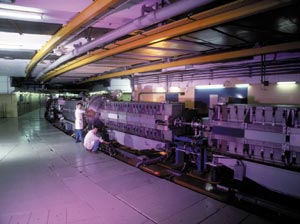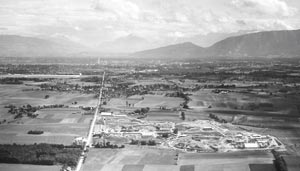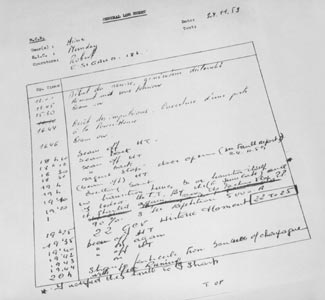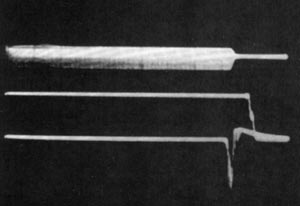Günther Plass looks back to the very beginnings of the Proton Synchrotron in the 1950s and its subsequent career as the centrepiece of CERN’s accelerator complex.

The timely construction and commissioning, in November 1959, of CERN’s Proton Synchrotron (PS) clearly demonstrated both the ability of the young European laboratory to turn a new concept into reality and the wisdom of the decision, taken as early as October 1952, to build an alternating-gradient synchrotron. Nobody involved could have imagined that the PS would remain the backbone of CERN’s scientific activities for more than 50 years.
The origins of the PS date back to May 1952, when the provisional CERN Council decided to build a 600 MeV synchro-cyclotron (similar to the one at Liverpool in the UK) and a “high-energy” PS (similar to the 2 GeV Cosmotron at Brookhaven), and to set up “SC” and “PS” groups. The initial members of the PS group were: Hannes Alfen (Sweden), Odd Dahl (Norway), D W Fry (UK), Wolfgang Gentner (Germany), Frank Goward (UK), Kjell Johnsen (Norway), F Regenstreif (France), Chris Schmelzer (Germany) and Rolf Wideröe (Switzerland).
Concept and design
The PS group set out to work on a synchrotron of the weak-focusing type, similar to the Cosmotron at Brookhaven, but with an energy of 10 GeV. Three members of the group, Dahl, Goward and Wideröe, went to Brookhaven in August 1952 for discussions with the Cosmotron’s designers. The American scientists, however, presented their visitors with a revolutionary concept for the design of future high-energy accelerators. Alternating the magnetic-field gradients while increasing them as much as possible would afford strong focusing of the beam, as occurs in a sequence of optical lenses, allowing smaller beam apertures and magnets for the synchrotron. Conversely, for a given magnet mass of a synchrotron, substantially higher particle energies could be obtained. This proposal became at once the subject of intense discussions with the inventors Ernest Courant, Stanley Livingston and Hartland Snyder. (This principle had been proposed independently by Nicholas Christophilos two years earlier.)
Two problem areas soon emerged: very high gradients would lead to very strong sensitivity to magnetic-field or alignment errors, and at a critical energy level – the “transition” energy – total beam loss would occur unless countermeasures were found. All the same, only two months later, in October 1952, the PS group convinced Council to launch a feasibility study of an alternating-gradient PS of “about 30 GeV” as the main project of the new laboratory. That demonstrated extraordinary insight as well as foresight and courage. The scene was thus set for the successful history of CERN as it developed – it surely would have been quite different had they opted for the old, “safe” way. In that session Council also selected Geneva as the seat of the laboratory. (We really should have celebrated CERN’s 50th anniversary two years earlier!)

Things proceeded with extraordinary speed in the following months. While the design of an alternating-gradient machine took shape in intense collaboration between the European and Brookhaven teams, diplomats, administrators and several eminent scientists worked hard on pushing the convention for the new international laboratory, in itself something never heard of before, through governments and parliaments to ratification.
In October 1953 the first members of the PS group, up to then split between half-a-dozen national laboratories, moved into preliminary premises at the Institut de Physique in Geneva, and at the end of the month a Conference on the Alternating-Gradient Proton Synchrotron was held there. Good progress in solving the problems inherent in the alternating-gradient principle was reported, and a conceptual machine design presented by the CERN group proved to be surprisingly similar to the PS as built six years later.
On 17 May 1954 ground was broken in Meyrin on the site proposed by Switzerland, and soon afterwards – with the formal beginnings of the European Organization for Nuclear Research on 29 September – staff could be recruited and contracts for equipment awarded on a firm basis. It may be hard in today’s world to imagine the excitement of those lucky enough to be recruited by CERN. It was an extraordinary privilege to collaborate on a truly pioneering European project and to work in one team with colleagues from neighbouring countries on, in the PS division, an almost unbelievable project: a high-precision machine of 200 m diameter that stretched technologies to their very limit and presented a need for initiative and invention in many areas. New arrivals experienced the continued hospitality – including a beautiful view from the rooftop at tea time – of the Institute de Physique, where some temporary buildings had been set up to cope with the numbers. These were wooden barracks, which only enhanced the feeling of being real pioneers. Time and again bursts of laughter pervaded the corridor, coming from the office of the leader of the magnet group, Colin Ramm, when ways were being discussed both to produce and reduce the cost of the thousands of tonnes of equipment that had to be purchased. In February 1956 the southern end of Lake Geneva (known as “la rade de Genève”) froze up – the last time this occurred during the 20th century! – and so did the heating pipes in those temporary barracks.

In June 1956, when the community gathered for the Symposium on High Energy Accelerators and Pion Physics, the viability of strong focusing was beyond doubt, though it had only been tested on a small-scale model at Brookhaven. The basic design of the PS was ready, staff numbers in the PS division were approaching 140, many of the important contracts with industry were being prepared and Kees Zilverschoon’s construction schedule (handwritten, since there were no computers yet) was established for finishing the project before the end of 1959.
Surprisingly, a Russian delegation (including a taciturn “expert” whose name nobody had ever heard before or after) obtained permission to participate in the symposium. Its members contributed a number of interesting proposals for advanced accelerating techniques, and above all, a good quantity of the drinks any Russian is brought up with – plus the quantity of caviar necessary to accompany them. Ivan Chuvilo of the Institute of Theoretical and Experimental Physics (ITEP) in Moscow never forgot his struggle with the Swiss customs about his “diplomatic” luggage, and surely all the conference participants will remember the Russian party at Hotel Metropol of 18 June (the day this author joined CERN).
First operation
Early in 1957 staff and laboratories moved to the new buildings at the Meyrin site. As from January, with parts of the roof still missing, the South and North Halls were fitted out for two years of testing, assembly, re-testing and storage of the accelerator components produced by industry in various member states. On 3 February 1959 the first of 100 magnet units was installed in the PS tunnel and the assembly of the synchrotron was finished by the end of July 1959 (see “CERN Courier Archive: 1959-2009”).
The injector – the 50 MeV linear accelerator – produced beam at the end of August, and beam circulating in the PS was obtained on 16 September, but all acceleration tests resulted in erratic beam behaviour for several weeks.

On 24 November, a memorable date indeed, Wolfgang Schnell installed new “phase lock” electronics in the beam-control system, with the grudging consent of Schmelzer, the RF group leader. (The original Nescafé tin containing the essential circuits is still available in his office.) When beam tests were resumed, the beam was accelerated at once, and even went through transition energy without difficulty; moreover, the team present (see “November 1959” photo below) hardly believed their eyes as they watched acceleration continue right through to 24 GeV. Finally on 8 December, after they corrected for magnet saturation, the peak energy of 28.3 GeV was attained.
The PS thus became the highest energy accelerator in the world for seven or eight months. Then its sister machine, the Alternating Gradient Synchrotron (AGS) at Brookhaven, was ready, which was somewhat larger and hence of higher energy capability. However, for the PS at CERN this was only the beginning of an extraordinary “career” of improvements and modifications, such that it has remained for 50 years the central member – the real heart – of the ever-increasing system of accelerators that has made CERN such a unique laboratory worldwide.
Improvements and new functions
While the machine was being carefully coached into routine operation and delivered first beams from internal targets, additional facilities and always higher intensities were already requested. A “fast” (short-pulse) ejection system was developed for neutrino experiments in the South Hall (soon to be relocated to a dedicated area). Also, to keep up with the steep increase in the number of users, another experimental area, the East Hall, was built, for which a “slow” (very long pulse) ejection system was needed for experiments on very rare or short-lived particles. Then, in 1965, when the Intersecting Storage Rings (ISR) project, designed to collide high-energy protons from the PS, was authorized as CERN’s first major extension, a second fast-ejection system and a dedicated transfer line were implemented.

Later in the 1960s, the construction of the “Booster” synchrotron was initiated to raise the injection energy to 1 GeV, and hence increase the beam intensity accepted by the PS, in response to continued requests. Simultaneously a programme to replace most of the first-generation subsystems of the PS was launched (see “A first round of improvements” box). The 50 MeV Linac could by then no longer provide the necessary intensity nor the reliability, and had to be replaced during the mid-1970s by an improved machine (Linac 2).
Also, just to make sure that no trick was missed, a working group at the time investigated whether different magnet structures for the PS tunnel, such as separate function magnets, might provide improved capabilities. The result was unambiguous: the machine as designed 20 years previously was the best to satisfy all requirements – an excellent job had been done.
In the late 1960s a 300 GeV Super Proton Synchrotron (SPS) became seen as a necessary step by European physicists, although finding a suitable site seemed like an imbroglio of geotechnical and political considerations impossible to solve, until in 1970 the proposal (dating from 1961) was resuscitated to build the machine under land adjacent to the original CERN site. After due discussion the proposal was formally submitted to Council in December 1970, and a special session approved it in February 1971, not least because the use of the PS as injector (and of other existing infrastructure) emerged quite naturally as an additional benefit. New beam-ejection and transfer modes, a dedicated acceleration system and delicate beam-matching procedures had to be developed for the PS in parallel with the improvement programme outlined above. Computer control then became a necessity, and refined operation procedures were conceived so that the ISR and the SPS, as well as the secondary beams, could run simultaneously.

Thus towards the end of the 1970s the intensity per cycle had been increased from about 1010 to more than 1013 protons, the cycle time had been shortened by a factor of three and machine availability had reached more than 95% of scheduled time. Operated and maintained by a superb team of competent and dedicated staff who were enthusiastic about the intricate system of accelerators and beam lines under their responsibility, the PS clearly was fit for even more demanding years ahead.
All these programmes were not quite finished when Carlo Rubbia, in 1976, brought forward the proposal for proton-antiproton experiments, which implied new challenges again for the PS. For antiproton production a 26 GeV proton beam of the highest intensity and density had to be provided, with all the beam concentrated in one-quarter of the PS circumference. Furthermore, the antiprotons from the antiproton accumulator were to be brought back to the PS for acceleration and transfer to the SPS.

The PS thus became a central element of the experiments in which the W and Z bosons were discovered, bringing the first Nobel prizes to CERN staff, with the awards in 1984 to Carlo Rubbia and Simon van der Meer. Also in the 1980s the PS became an antiproton decelerator supplying the Low Energy Antiproton Ring (LEAR). It still provides the high-intensity primary proton beam for LEAR’s successor, the Antiproton Decelerator (AD), where delicate experiments continuing the tradition of LEAR are running today.
A universal accelerator
For some time, ideas for a programme of research with heavy ions had been looming in the physics community. Early in the 1970s tests with deuterons and alpha particles were run in the “old” Linac 1, which was dedicated to ions after the construction of Linac 2. Equipped with a new front end, Linac 1 provided beams of oxygen and sulphur ions for acceleration in the PS, so that by the mid-1980s experiments with these ions could run at SPS energies.
Eventually Linac 1 was replaced by a dedicated heavy-ion Linac (Linac 3) constructed by a collaboration involving CERN, GANIL, GSI, IAP (Frankfurt), Indian institutes and INFN (Lugnano), as well as financial contributions from the Czech Academy of Science, and the Swedish and the Swiss delegations. Since 1994 the PS has therefore been fit for providing ions as heavy as lead for experiments at the SPS and, in future, the Large Hadron Collider (LHC).

The 1980s and 1990s were the main decades for CERN’s Large Electron Positron collider (LEP). This was originally planned to have a dedicated injector synchrotron for electrons and positrons, but when Council put the brakes on the budget, people’s minds turned once again to the PS.
It turned out that the combination of the PS and the SPS, equipped with suitable acceleration systems, would make an adequate injector for LEP. Space was made available near the PS circumference for the electron and positron sources and pre-accelerators, to which the Laboratoire de l’Accelerateur Linéaire (LAL) at Orsay made significant contributions. New inflectors, a new vacuum chamber, wiggler magnets and a dedicated acceleration system for electrons and positrons had to be installed in the PS so that, for a dozen years or so, it became the universal accelerator for all stable charged particles.
Finally, protons and heavy ions for the LHC will of course come from the PS (through the SPS). The beam current will have to be increased once more with a new front end for Linac 2. To accommodate the increased current, the transfer energy from the booster to the PS has been raised to 1.4 GeV, and both machines need, among a number of other adaptations, to be equipped with new acceleration systems synchronized to the acceleration systems of the SPS and the LHC.

For 45 years this machine has been adapted successfully to the requirements of the physics programme, while both in the minds of people and in fact (its basic focusing structure has remained untouched), it is still “the PS”. Understanding the physics of beams in accelerators, refined beam observation and measurements, ingenious inventions, powerful computers for beam simulation and controls, as well as a few decades of general progress in many technologies (vacuum, electronics, RF, high stable and fast power sources, materials, etc), along with motivated staff, were all necessary ingredients for this development.
Young physicists of the 21st century, as enthusiastic to work at CERN as those of 50 years ago, will surely not hesitate to teach the old lady a few new tricks. When one day, maybe quite remote, the PS finally faces retirement, people should remember CERN’s founding fathers and the participants in the historic Council session in October 1952 for their courageous decision, and the original machine designers for their excellent job.








